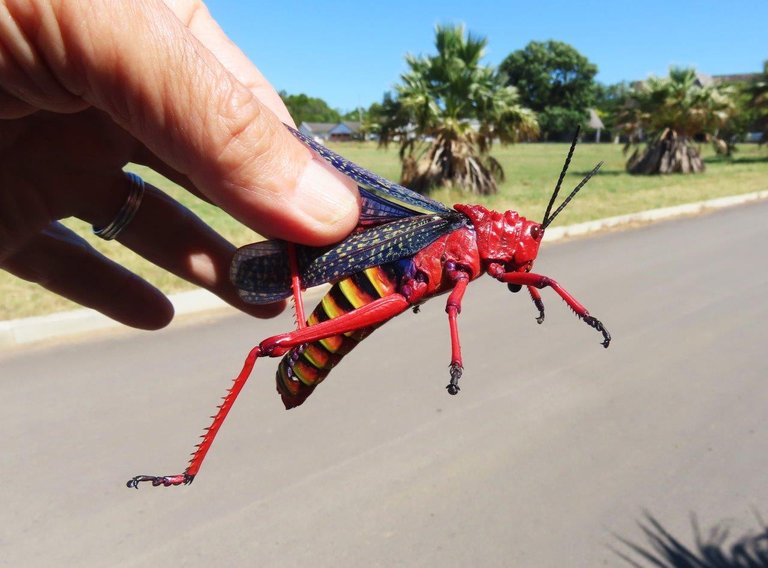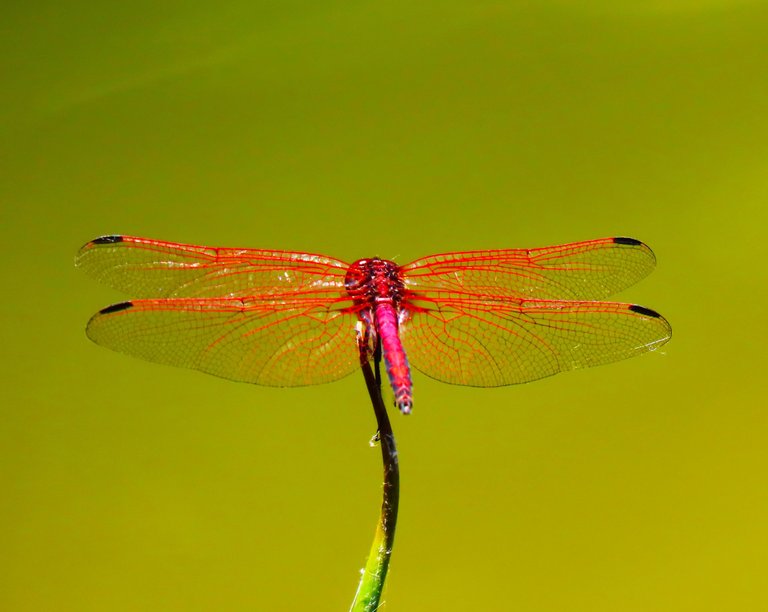All wildlife in nature knows that the color red means poison.

This is a Milkweed Locust, and swarms of them can destroy farm crops in a few hours. Not much loved, by we could not allow a car to run over it on the road.
I was out taking photos of the cloudy mountains, and my wife was waiting in the car. She spotted the female walking on the road, as the females cannot fly. So, she tried to guide it to a safer spot, but things didn't go very well, so she called me to come and help.
Phymateus are African grasshoppers that typically are about 4–8.5 cm (1.6–3.3 in) long as adults, with females generally being larger than males of the same species. Some species at maturity are capable of long migratory flights. They raise and rustle wings when disturbed and may secrete a noxious fluid from the thoracic joint. Their toxins, which are accumulated from the toxic plants they feed on, can be very strong and there have been reported deaths in birds and mammals, including humans, after eating Phymateus grasshoppers.
While they do show a preference for feeding on certain toxic plants, notably Asclepias milkweeds, they will feed on a wide range of plants, and are sometimes regarded as pests because of the damage they may cause to agricultural crops. They may congregate in large numbers on trees and shrubs, in some species arranged in such a way as to resemble foliage. Other species have bright aposematic warning colours. Although adults of both sexes are fully winged, in at least P. morbillosus the females, which are longer and considerably heavier than males, are unable to fly.
She felt that I would put her down, but no, I wanted to see her releasing her toxic poison.
Ah! there we go, as look at the poisonous bubbles popping out behind her leg. They also drop a black poisonous substance out from their mouths.
Here is a better look at the bubbles of poison.
So, I put her down under a palm tree, and somehow, I know that she is not going to make it.
Let's rather have a look at some beautiful dragonflies.
A pair of male dragonflies sat on a water plant, so I took each one individually and also together on the plant.
This is a Red-veined Dropwing (Trithemis arteriosa) dragonfly.
And the blue one looks like a Cape Skimmer (Orthetrum julia capicola).
Here below you can see both of them sitting on a plant.
The Red-veined seemed to be playing with a piece of string.
A first for me to get two males together on the same plant, as normally dragonflies fight each other to protect their territories. We are always so excited after winter when spring arrives, and then the dragonflies start to appear in early summer. They are not poisonous, and they can't hurt human beings, like the locust up in the post. Incidentally, while my wife was looking up on the locust there was a story of a lady who lost her little dog after eating one of the locusts. I know that some people here, love to eat grasshoppers, but I just hope and pray, that they don't eat one of these. The milkweed plants are invasive species from other countries. They are not natural to South Africa. We now have a serious problem, not only with the locusts, but also with the other foreign insect species, such as the Yellow-jacket wasps and the borer beetles. But our scientists are hard at work to find solutions, in order to eradicate the pests.
I hope you enjoyed the pictures and the story.
Photos by Zac Smith-All Rights Reserved.
Camera: Canon PowershotSX70HS Bridge camera.
Thank you kindly for supporting this post.











